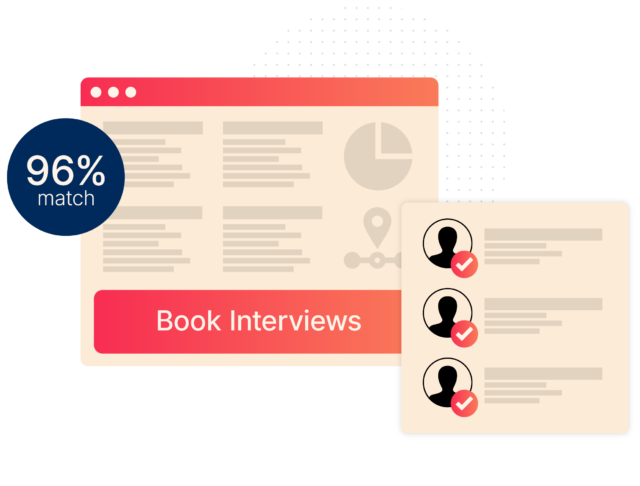11 Tips For Overcoming Retail Recruitment Challenges
Recruiting the right talent is critical to success in the retail industry. But, as we all know, it’s not without its challenges. From high turnover rates to a shortage of skilled
candidates, retailer recruitment is often an uphill struggle to attract and retain qualified employees.
In this article, we will explore 11 valuable tips to help retail businesses overcome these recruitment challenges and build a solid and capable workforce.
But first, let’s analyze the challenges with retail recruitment in more detail.
The Key Challenges Facing Retail Recruiters Today
High Volume Hiring
Retailers today have to do much more recruiting legwork just to maintain their current workforces, much less meet their seasonal workforce requirements.
The need for high-volume hiring within retail is a regular occurrence because the industry often experiences fluctuating demands, especially during peak seasons or holidays. This requires retailers to hire a large number of temporary or seasonal staff to meet customer demands. And, if employment trends from previous years have taught us anything, it’s that the need for mass hiring isn’t limited to particular times of the year either.
Recruiting, screening, and onboarding a large volume of candidates within a short period can be overwhelming, especially when it feels nearly constant. To overcome this challenge, retail recruiters can adopt some practical strategies.
Leveraging technology such as Applicant Tracking Systems (ATS) can help automate the recruitment process, streamline candidate screening, and efficiently manage a high volume of applications. While creating talent pools and establishing relationships with temporary staffing agencies can provide access to pre-screened candidates who can be quickly deployed when needed.
Seasonality
Seasonal hiring has long been a staple challenge for retail recruitment leaders, with larger Retailers starting their seasonal hiring as early as summertime.
Seasonality takes the challenge of volume recruiting to a new level — with recruiters needing to screen, engage, and hire thousands and thousands of workers in a very short timeframe.
Retail recruiters should plan ahead and anticipate peak periods. This involves forecasting sales patterns, analyzing historical data, and identifying the specific times when additional staff will be required. By planning in advance, recruiters can initiate recruitment campaigns, build talent pools, and establish relationships with temporary staffing agencies to ensure a seamless transition during busy periods.
Providing thorough training programs and clear guidelines to seasonal hires will also help them quickly integrate into the team and deliver exceptional customer service.
Ghosting and the Casual Candidate
Volume recruiting is made more complex by ghosting, a phenomenon that, as This Washington Post Article discusses, is on the rise, likely largely due to low unemployment rates. Ghosting is when “Someone Suddenly Ends All Communication Without An Explanation.”
In recruitment terms, ghosting refers to candidates who disappear without any communication, leaving recruiters unsure of their status or whether they are still interested in the position.
Today almost all candidates are considering another job offer when they consider yours. As explained by Gartner Analyst Jason Cerrato, candidates have shifted from “committed” to “casual”: candidates apply to more jobs with less upfront research and shortlist their top picks only after they have met with recruiters. This means employers are dealing with High Volume Hiring and longer cycles of consideration than before.
Retail recruiters can focus on improving communication and engagement throughout the recruitment process to mitigate ghosting and manage casual candidates. Promptly acknowledging applications, providing regular updates, and
maintaining consistent communication with candidates can help build trust and reduce the likelihood of ghosting.
Conducting thorough interviews and reference checks can help identify committed candidates and minimize the risk of last-minute withdrawals. Additionally, incorporating assessments or trial shifts during the hiring process can give both recruiters and candidates a better understanding of the role, increasing the chances of finding the right fit.
Economic uncertainty
Economic factors, such as recessions, inflation, or market volatility, can impact consumer spending patterns and, consequently, retailers’ hiring decisions. Uncertainty regarding market conditions and future business prospects can make retailers hesitant to make long-term hiring commitments.
To navigate economic uncertainty, retail recruiters can adopt a flexible approach to hiring. This includes implementing a mix of permanent and temporary staffing solutions to adjust workforce size according to market demands. Building a Talent Pipeline and maintaining relationships with passive candidates can be beneficial when business conditions improve and new positions become available.
Put simply, agility is a critical business capability for retailers now and in the coming years. Retailers need to be prepared to adapt their business strategies on a dime — and their recruiters need to be able to modify their recruiting strategies and processes in quick response to these business changes.
Retail Recruitment Agencies vs. Retail Recruitment Software
When it comes to retail recruitment, businesses have traditionally relied on a retail recruitment agency to find suitable candidates. However, with technological advancements, retail recruitment software has emerged as a viable alternative. Let’s compare the two approaches and understand their pros and cons.
The Benefits of Talent Acquisition Software for Retail Recruitment
- A Streamlined Process. Retail recruitment software simplifies and automates various aspects of the hiring process, from job posting and applicant tracking to scheduling interviews and managing candidate data. This streamlining saves time and effort, allowing recruiters to focus on evaluating candidates.
- Enhanced Candidate Experience. Talent acquisition software offers user-friendly interfaces, mobile compatibility, and seamless communication channels. This improves the candidate experience and reflects positively on the employer brand, attracting top talent.
- Improved Efficiency. Retail recruitment software boosts efficiency and reduces manual errors by automating repetitive tasks. Recruiters can utilize their time more effectively by concentrating on strategic activities like candidate assessment and engagement.
- Data-Driven Decision Making. Recruitment software provides valuable analytics and reporting capabilities. These insights enable recruiters to analyze recruitment metrics, identify bottlenecks, and make data-driven decisions to optimize their hiring processes.
11 Retail Recruitment Strategies to Ensure a Robust Hiring Process
So what can you do to make your retail recruiting process as smooth as it possibly can be?
1. Ensure your recruiting system can really handle high volume
The faster you can move candidates through your recruiting processes, the more competitive you can be. Yet many recruiting systems aren’t technically able to process high volumes of candidates fast enough to meet business needs.
Make sure your system has the bulk processing capabilities needed to action a high volume of candidates quickly, so you can hire at the pace of the business. (Read The Marks And Spencer Case Study.)
Logical, data-driven automation capabilities are also critical. A system that is able to drive candidates down the appropriate workflow path without the need for recruiter interactions can accelerate the recruiting process and get you candidates quicker. The more automation, the better when dealing with High Volume Recruiting.
2. Create diverse recruiting processes
Sameness is mediocrity and one recruiting process certainly does not fit all. To be competitive, create strategies and workflows that are tailored by role type, geography, volume needs, to give just a few examples. Don’t limit your team to just one or two workflows.
3. Be ready to adapt your recruiting processes
New stores opening. Higher turnover rates. The need to accelerate hiring for certain roles. These are just a few of the reasons recruiters need to be able to adapt their recruiting strategies and workflows quickly. Ensure your system is not only flexible enough to support your unique workflows, but also allows processes to be changed on a dime.
4. Automate administrative tasks
Look to automate administrative tasks, making processes and Candidate Experience as quick and seamless as possible, keeping candidates informed and engaged. For instance, automate interview scheduling, testing and assessments, and onboarding tasks. Consider how you can automate the tasks associated with “super hiring” days and Events to reduce the burden on recruiters.
5. Care deeply about Diversity And Inclusion (D&I)
D&I isn’t just the secret to greater business success (as proven time and again by research), it is also the secret to widening your talent pools and improving your new hire retention rates, creating an environment where everyone feels included. Ensure your retail recruitment processes not only bring in diverse talent, reflecting the communities you serve, but are an inclusive experience.
6. Leverage artificial intelligence (AI) to debias recruiting and achieve better results
Using AI and prescriptive analytics to support decision making means allowing recruiters and hiring managers to reduce the time they spend on these tasks.
Recruiting Solutions are available that harness machine learning technology (and reams of data) to score candidates based on their skills, Cultural Fit, offer acceptance probability, and probable retention.
This Reduces Bias (correctly implemented machine learning algorithms will overcome human biases in candidate selection and widen your talent pool), saves time (high scoring candidates can be moved forward in the process automatically), and allows recruiters to focus more of their time on high return activities such as recruiting strategy, developing relationships with candidates, and having career conversations with candidates.
7. Ensure an exceptional candidate experience
In the era of the casual candidate it is critical to provide a great Candidate Experience. From targeting candidates with multi-channel recruitment ads to tailoring your nurturing campaigns to ensuring your top candidates enjoy relevant content that keeps your company at the top of their minds, look to leverage tools that will help you nurture the right relationships and strengthen your pipeline.
Additionally, aim to simplify the experience for candidates, avoiding complex online application processes.
8. Partner with Hiring Managers and Beyond
Hiring managers can make or break your Recruiting outcomes. Enable busy managers, who spend more of their time on the shop floor than a desk, with automated interview scheduling, simplified Interview Feedback capture, and digitized onboarding.
9. Measure, measure, measure
As Peter Drucker famously said, “If you can’t measure it, you can’t improve it.” Whether it is measuring recruiting efficiency and effectiveness, uncovering areas of bias in recruiting processes, or understanding the diversity of your pipelines, measuring and monitoring your results is critical to continued improvement.
10. Speed is everything
Admittedly, this tip is a consolidation of several above. But in today’s recruiting environment, speed really is everything.
Whether it’s handling large volumes of candidates via bulk processing, automating process steps and tasks, responsively adapting recruiting workflows, or leveraging AI and machine learning to facilitate better and faster decision making, retail recruiting speed — when achieved without sacrificing quality — is an unassailable competitive advantage.
11. Engage known talent
Keeping past candidates and seasonal workers engaged throughout the year can make a significant difference in enabling you to quickly fill both permanent and seasonal/part time opportunities. Take a multi-pronged approach to engagement: share content, event invitations, and personalized outreach with your talent pool all year long, tailoring your approach by audience for greater success.
Retail Recruitment Software: Smooth Out Your Talent Acquisition Process
You should now have a firm grasp on the numerous challenges facing modern-day recruiters and the steps you can take to alleviate them.
If you’re looking for comprehensive Retail Recruitment Software for your high-volume hiring needs, Oleeo has you covered. Our intelligent automation takes talent from application to interview in as little as 35 minutes and application to hire in three days.
Our AI removes bias from the candidate selection and filtering process, ensuring you are left with a diverse selection of candidates.
Why not Book A Demo today and see how making us part of your retail recruitment strategy can help your business?



